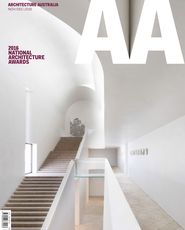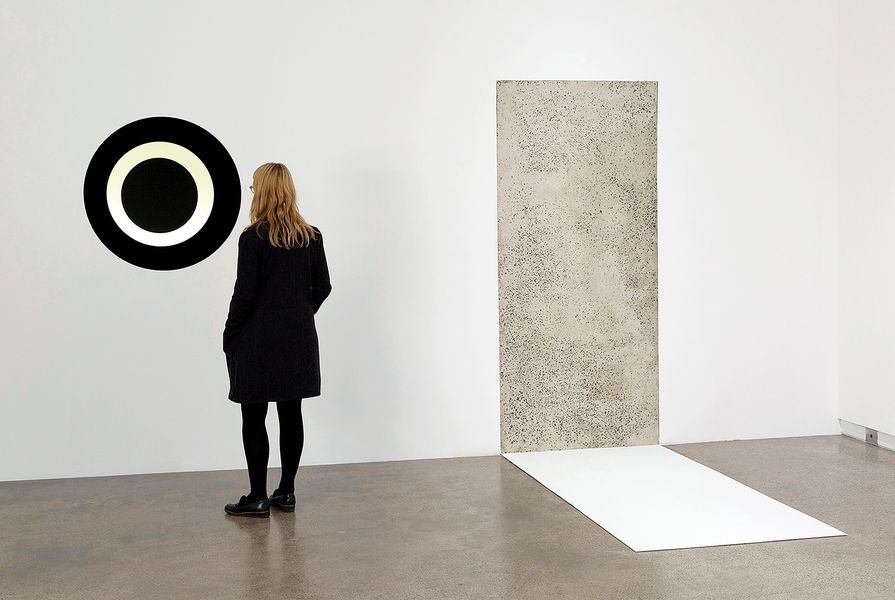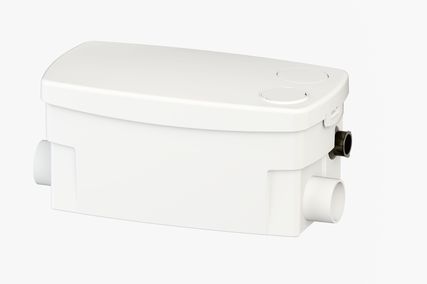“In the end it is just a frame” – with these words Natasha Johns-Messenger summed up her work and practice. Working with what is already there, art and architecture are brought into a dynamic relation with each other as framing mechanisms in the production of images.
While this sounds like a form of site-specific art practice, Johns-Messenger’s approach is not about making specific in the sense of making a relation that specifies something. Instead, in her exhibition Sitelines at Heide Museum of Modern Art, lines of site are activated to animate the gallery in ways that suspend the process of recognition. Perceptions are tricked, assumptions are confronted and you have to look without recourse to logic or memory to make sense of what is seen.
As a “site artist,” Johns-Messenger spent six months at Heide, where “the act of looking is like a job. If I don’t see a new layer, how can I expect the viewer to?” She is fascinated with the lens of the eye and what is seen before the mind makes something of it. Referring to her background in painting and drawing – where you are told to draw what you see, not what you think you see – Johns-Messenger is concerned to work with, and show, “just what there is” as distinct from exhibiting or representing Heide.
The works in Sitelines are quite literally lines of site brought into the gallery – frames of canvas and film, windows, entrances and mirrors – and presented to the viewer. On entering the first gallery, you encounter what appears to be a conventional gallery hang of abstract paintings with some sculptural works. The frame of Heide as a museum of modern art activates such expectations and sightlines are set up that position the viewer as perceiver. As you move closer to the works, these sightlines are disrupted and you cannot work out quite what you are looking at; there is a strong material quality to the images, yet they are abstract. Reading the title Heide Site Photos leads you to see that they are actual photographs. These are images made from what has been seen – and, critically for a viewer, an invitation to see what can be seen. Heide Site Photos are photographs of actual details seen on site.
An installation view of Echo (2016) and Skytree (2016) by Natasha Johns-Messenger.
Image: Christian Capurro
These photographs have no surface reflection; they are not sealed or behind glass. The pigment is exposed, creating a sense of depth, richness and fragility. This lack of reflection renders your presence as a viewer differently from that of a viewer whose sightlines are privileged. You study the surface intently; there is a haptic quality that invites you to move close and produces that sensation where you want to reach out and touch to verify what the eye cannot. This is different from an optic viewing of perceiving with a sense of distance. The habitual act of perceiving is disrupted, suspended, even frustrated as you work to see material, spatial and temporal conditions such as those in Herethere, a material and spatial transposition of white wall and concrete floor where wall becomes floor and floor becomes wall.
Another frame in this first gallery is more overtly an architectural one – a corridor titled Echo that appears to run centrally through the interior of the building, ending with a window. Entering this space, you realize it is composed of floor-to-ceiling mirrors angled on a diagonal. Lines of site are activated from one end of the gallery to the other, with the entrance and end window in visual relay.
While there is reflection with the mirrors – like the site photos – the line of reflection is not of you but of the site. As a viewer, your sightlines are deflected as site lines determine how you see and are seen. Watching people enter and move through the space, you see that they do not produce a reflection until they move to the side and then they are pictured centrally in the corridor as you had first expected they would be. Commonsense logic is defied. You need to look attentively – open and curious – exposed to Heide’s site lines. A strange sense of delay is produced as though you have encountered that moment of the present before you occupy it by making sense of it.
An installation view of Enfolder (2016) by Natasha Johns-Messenger.
Image: John Gollings
This odd timing is also encountered in Enfolder – a carefully crafted and detailed “room” that you have to enter with your body side-on, with only your head and shoulders accommodated. Mind and body are sculpturally separated in a circular corridor of mirrors. Inside, you meet yourself coming in from the side rather than face-to-face, as if to share some intimacy together; at times you become intimate with the back of your head and then with that of others (like the man who lifted his hand to check something he had perhaps not seen before – a thinning patch of hair). There is a multiplicity of yous produced by these site lines – some you see; some yous others see.
This tricking of your sightlines displaces the centrality of the viewer as the producer of meaning. This is done without making illusions or digitally altered images. Sitelines invites you to “unassume” and, in these images, see framed lines of the actual.
Heide Site Film extends the image making of the Heide Site Photos as a collection of images taken around Heide. A film requires you to pause and watch each frame pass. There is a stillness in this film, coupled with a sense that each image and frame is animated. The concrete is breathing; the tree is no longer an object but a shimmer of light as leaves reflect the sun, which slowly recedes to become an abstract painterly line of light at dusk. An animistic quality activates the whole site – the show and Heide – impressing on you a sense that these site lines are alive and that the meanings you impose are perhaps not as wondrous as what is already there and can be seen.
Sitelines is “just a frame” that brings in lines of site, making images that interrupt habitual sightlines and enable people not only to see Heide differently, but also to experience the potential that comes from suspending your own assumptions about what there is, to pause and to see without imposing your reflection.
Source

Discussion
Published online: 9 Jan 2017
Words:
Suzie Attiwill
Images:
Christian Capurro,
Courtesy of the artist,
John Gollings
Issue
Architecture Australia, November 2016





















